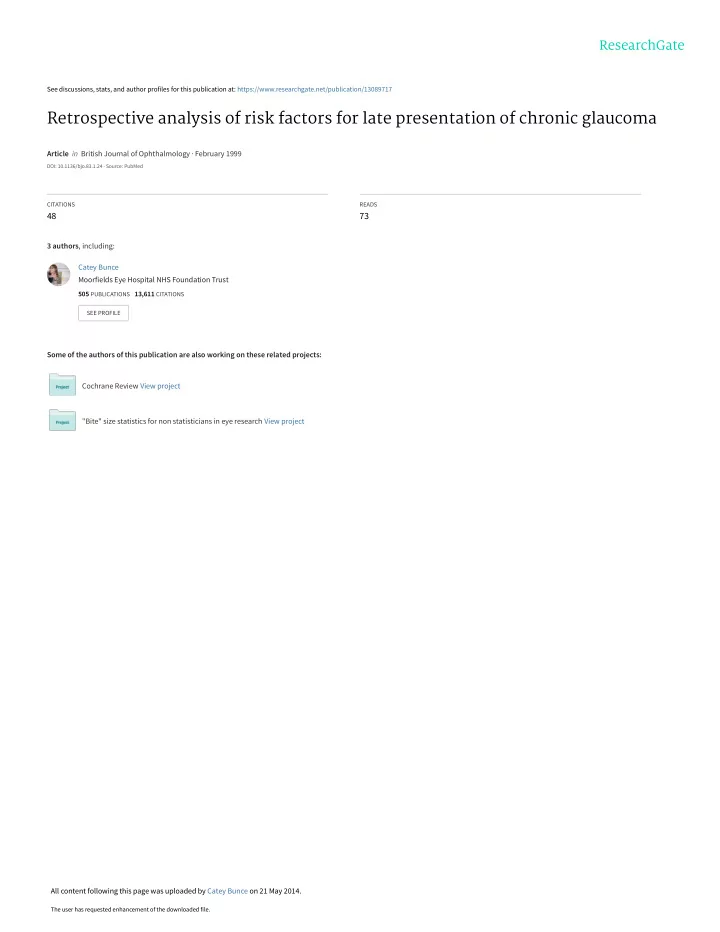

See discussions, stats, and author profiles for this publication at: https://www.researchgate.net/publication/13089717 Retrospective analysis of risk factors for late presentation of chronic glaucoma Article in British Journal of Ophthalmology · February 1999 DOI: 10.1136/bjo.83.1.24 · Source: PubMed CITATIONS READS 48 73 3 authors , including: Catey Bunce Moorfields Eye Hospital NHS Foundation Trust 505 PUBLICATIONS 13,611 CITATIONS SEE PROFILE Some of the authors of this publication are also working on these related projects: Cochrane Review View project "Bite" size statistics for non statisticians in eye research View project All content following this page was uploaded by Catey Bunce on 21 May 2014. The user has requested enhancement of the downloaded file.
24 Br J Ophthalmol 1999; 83 :24–28 Retrospective analysis of risk factors for late presentation of chronic glaucoma Scott Fraser, Catey Bunce, Richard Wormald Abstract presenting with advanced and irremedi- Background —Why some individuals able field loss. present to the ophthalmologist in the early ( Br J Ophthalmol 1999; 83 :24–28) stages of chronic glaucoma but others present with very advanced visual field loss Despite extensive research and new treatments is a question which has received little glaucoma remains a major cause of blindness in attention. This study is an attempt to iden- the developing and developed world. Risk tify some basic characteristics of people factors for the development of glaucoma have who present with late glaucoma. been extensively investigated but those for glau- Methods —A retrospective case-control coma blindness have received little attention. study by medical record review was A number of workers have shown that employed. 100 cases and 100 controls were patients who present with advanced glaucoma identified from the notes of patients are at a substantial risk of blindness. 1–3 Grant presenting to Moorfields Eye Hospital and Burke found that eyes with a visual field glaucoma service between July 1993 and defect at the start of treatment were more likely July 1995. Cases were defined as new to progress to blindness than eyes in which patients presenting with absolute field treatment is started at the stage where there is loss within five degrees of fixation and a no field loss (although whether all the patients cup to disc ratio of greater than 0.8 in one in the second group had glaucoma is di Y cult or both eyes. Controls were new patients to ascertain). 1 Wilson et al looked at risk factors with no absolute field loss within 20 for rate of progression of glaucomatous visual degrees in either eye, but otherwise field loss in 57 patients and found that initial typical glaucomatous field loss and a cup visual field was the strongest determinant of to disc ratio of greater than 0.5 or a rate of further visual field loss. 4 Patients in their di V erence of 0.2 or more between the study deteriorated 11.7 times faster in the discs. more advanced eyes. Mikelburg et al measured Results —The ethnic origin, sex, referral scotoma mass of fields and compared them with the rate of subsequent decline. 5 They source, presenting IOP , and age of the subjects studied were independently asso- found that when scotoma mass was small (that ciated with late presentation. An African is, early disease) rate of visual field loss was Caribbean patient is estimated to be four slow but when the scotoma mass was large, and a half times more likely to attend with rapid linear progression of visual fields oc- advanced field loss than a white patient of curred. Miller and Karseras stated that, from similar age, sex, IOP , and referral source their series, glaucoma is more benign in (adj OR: 4.55, 95% CI [1.57, 13.18]). A patients with considerable visual reserve. 6 female patient is estimated to be one third These studies suggest that late presentation (0.34, [0.15, 0.74]) as likely to attend late is a considerable risk factor for glaucoma than a male patient of the similar age, blindness. IOP , ethnic origin, and referral source. A patient referred via any source other than Patients and methods an optometrist with the correct diagnosis All patients referred from the primary care is estimated to be greater than four times clinic at Moorfields Eye Hospital to the (4.32 [1.89, 9.88]) more likely to be a late glaucoma service between July 1993 and July attender than a patient of the same sex, 1995 who had not previously been diagnosed ethnicity, and similar age but referred as having chronic glaucoma were identified. with a diagnosis of glaucoma. There was a For simplicity, the first 100 consecutively trend of increasing odds of late presenta- identified cases and 100 controls that fitted Glaxo Department tion with increasing age (adj OR per 10 the criteria were used. This study was a pilot, of Ophthalmic years, baseline 40–49 years 1.68 [1.22, an objective of which was to provide estimates Epidemiology, 2.20]). A patient whose presenting IOP is for use in sample size calculations in subse- Moorfields Eye Hospital, City Road, 21–25 mm Hg is estimated to be a quarter quent work. London EC1V 2PD (0.24, [0.09, 0.64]) as likely to attend with Cases were defined as typical glaucomatous S Fraser advanced field loss than a patient of the field loss within five degrees of fixation but C Bunce same ethnic origin, sex, age, referral beyond 30 degrees in one or both eyes. The R Wormald source, but with presenting IOP of glaucoma could be of any chronic type as long greater than 31 mm Hg as field loss was present. There had to be at Correspondence to: Mr S G Fraser. Conclusions —These data strongly suggest least two consecutive fields confirming loss and that certain subgroups of patients with a cup to disc ratio of more than 0.8. The only Accepted for publication glaucoma are likely to be at greater risk of exception to this was when the field loss was so 31 July 1998
Recommend
More recommend